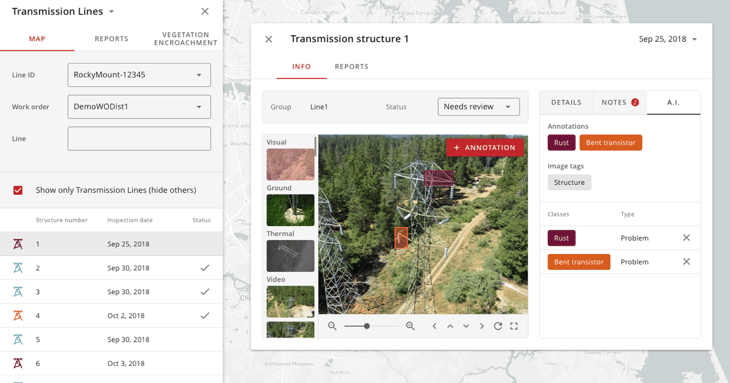The following is an excerpt from our Enriching Data, Empowering Action whitepaper. You can access the full report here.
Utilities need the right data to make smart business decisions—but there also needs to be enough of it. Collecting enough good, real-life data to ensure positive business outcomes can result in datasets in the millions of images; when you have this amount of data, processing it is a time- and resource-intensive task. That’s why PrecisionHawk hands this task off to its machine learning model.
Rather than training a model on every single image in a large dataset—for example, five images each of the 275,000 distribution poles in a utility’s network—PrecisionHawk’s data engineers train the model on a small subset of the data and monitor the performance early on. This allows the data engineers to quickly assess where improvements are needed. The model learns the easier, more repetitive tasks first, freeing the data team to focus on edge cases and outliers to ensure the robustness of the model.
In addition, the machine learning model employs filters to separate the noise from the valuable data, resulting in a more manageable amount of data. This reduces processing time and storage costs while providing the most accurate results.

More Than Image Volume
There’s more to amplifying data than increasing the number of images. A large volume of images is important, but these other aspects need to be amplified as well:
-
The right angles. When the application calls for it, PrecisionHawk’s team can use drones to capture images of interior angles inaccessible to ground crews and manned aircraft.
-
A high level of detail and focus. Ultra-high-resolution cameras, LiDAR models, and image analytic algorithms ensure that even the smallest issues are easily visible.
-
The proper tags. Humans need high quality, real-life imagery, not just data models—but for machines to be able to process these images, they need tags that, for example, indicate the location of the asset. The PrecisionHawk solution offers both
-
High temporal resolution. This is the amount of time between revisits to acquire data for the exact same location. The high temporal resolution of drones allows for the rapid and cost-effective capture of essential decision-support data.
Breaking down data silos
Good data is amplified further by being shareable. PrecisionHawk’s open API layer allows PrecisionAnalytics to push information into not just one system, but into the many various systems commonly used by enterprise clients.
This means the solution can identify issues before they become emergencies and add them directly to the maintenance plan. For example, let’s say a utility needs to monitor a substation defense for security issues. If PrecisionHawk’s visual detection system reveals a hole, PrecisionAnalytics can automatically push the information into the utility’s security system, and the utility can then have the problem addressed immediately.
Not only that, PrecisionAnalytics creates easily understood reports that can be shared among stakeholders, enabling the data to be used across the organization to refine capital budgets, fuel network engineering strategy, apply for permits, prove regulatory compliance, and more.
Data that Drives Results
Accelerating, automating, and amplifying data helps utilities collect the vast amounts of data needed to ensure accuracy and usefulness, because AI and machine learning can filter that data down to the most relevant information. The balance of automation and human intervention makes the process cost effective, as well.
With the right data, utility personnel can now make the best decisions to increase safety, customer satisfaction, and cost savings—decisions that will benefit the utility today and tomorrow.
The bottom line: by deploying PrecisionHawk’s data solution, enterprises can improve every step of their inspection process—from collecting data to deploying repair crews.
Download the full Enriching Data, Empowering Action whitepaper today to learn how data-powered decision-making can help you reduce downtime, increase safety, and lower costs.




